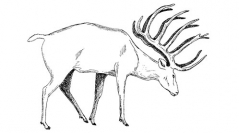

 Geodiversitas
26 (4) - Pages 661-674
Geodiversitas
26 (4) - Pages 661-674The mesowear method is applied to reveal the type of forage eaten by the late Villafranchian deer of Ceyssaguet (Haute-Loire, France). Further, habitat properties of the paleoenvironment of Ceyssaguet are reconstructed. The most common deer species, Eucladoceros ctenoides Nesti, 1841 and Metacervoceros rhenanus Dubois, 1904, are interpreted as abrasion-dominated mixed feeders with close to 45% grass in their forage which was similar to that of the south east Asian hog deer and sambar. A third deer species, Praemegaceros obscurus Azzaroli, 1953, represented only by three fossil specimens, is interpreted as a more attrition dominated mixed feeder. Combined with mesowear analysis, taphonomical and morpho-functional data allow the reconstruction of the paleoenvironment of Ceyssaguet as an open grassland with wooded habitats near the lake, under cold climate.
Mammalia, Cervidae, early Pleistocene, France, mesowear analysis, paleodiet reconstruction, paleoenvironment